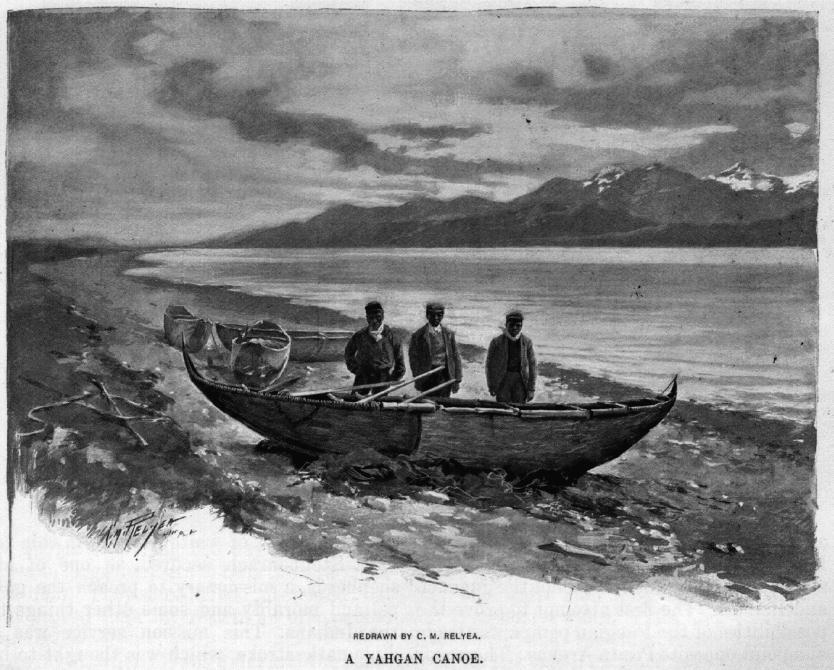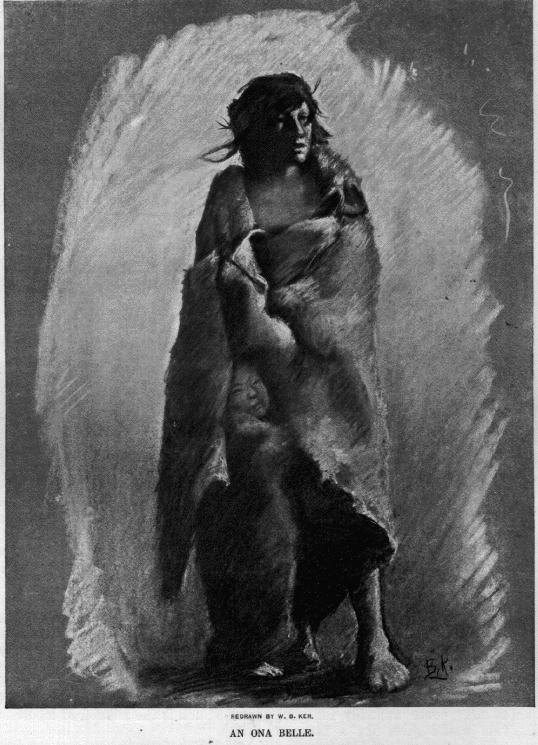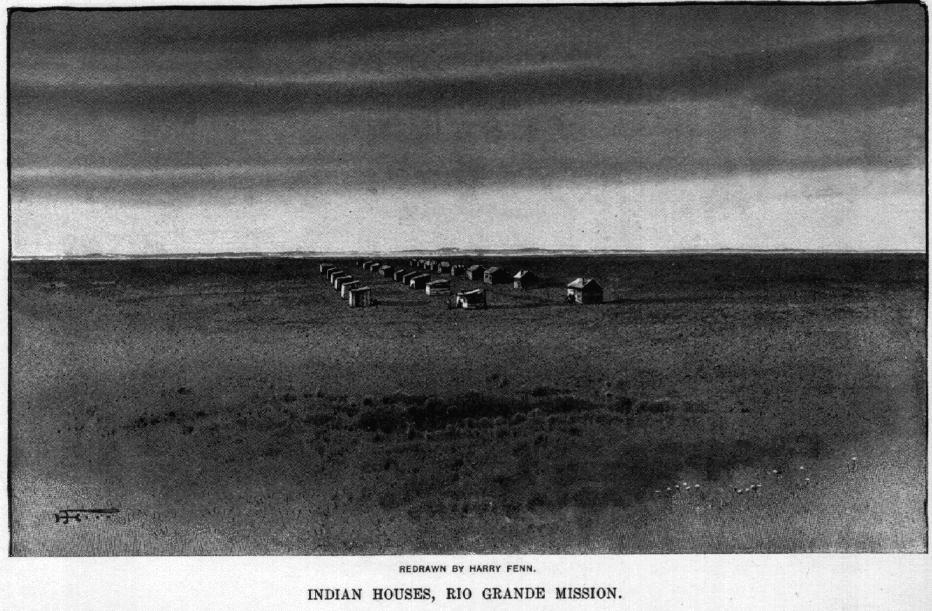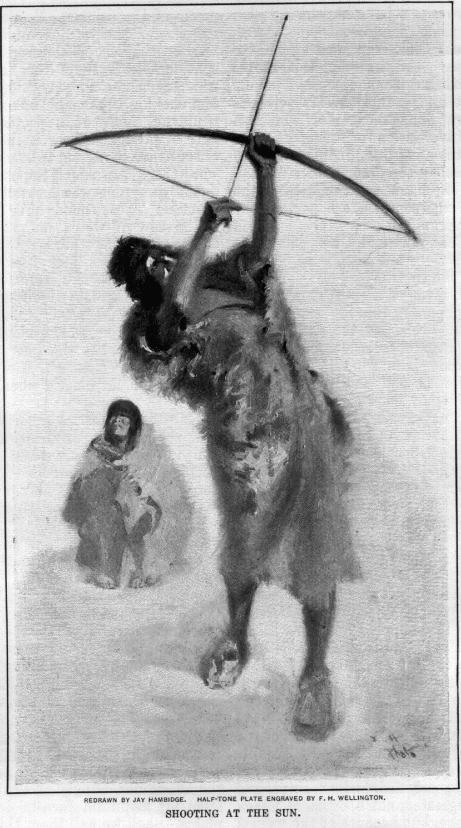| The Giant Indians of Tierra Del Fuego | ||
THE GIANT INDIANS OF TIERRA DEL FUEGO.
BY DR. FREDERICK A. COOK,
Of the Belgian Antarctic Expedition.
WITH PICTURES DRAWN FROM PHOTOGRAPHS TAKEN BY THE AUTHOR.
THE Fuegians have been reported, from time to time, since the country was first sighted and named by Magellan in 1520, but to-day they still remain almost unknown. In connection with the voyage of the Belgica we had unusual opportunities for studying their wild life and their weather-beaten land. They are not, as is generally supposed, one homogeneous tribe, but three distinct races, with different languages, different appearances, different habits and homes.
In the western Chilean channels, living in beech-bark canoes and in dugouts, using mussels, snails, crabs, and fish in general as food, are the short, imperfectly developed Aliculufs. These are met by many vessels navigating the Strait of Magellan, and most of our reports of Fuegians are limited to hasty glimpses of these people; but they are now nearly extinct, and they always were the lowest and the most abject of the Fuegians.
Closely allied in habits to the Aliculufs are the Indians inhabiting the islands about Cape Horn and northward to Beagle Channel. These are called Yahgans. They have been the most numerous and the most powerful of the Fuegian people, but to-day they too are nearly extinct. They are dwarfed in stature, dwarfed in mental development, and, like the Aliculufs, live in canoes, and feed upon the products of the sea.
The third tribe is the race of giants. They are called Onas by their neighbors, the Yahgans. The Onas have thus far evaded all efforts at civilization, have refused missionaries, and have, to the present time, with good reason, mistrusted white men. They have, in consequence, remained absolutely unknown.
The homes of the Onas are on the main island of Tierra del Fuego. For centuries they have fought to keep this as their preserve; but the Yahgans have been allowed to pitch their homes on the southern coastal fringe along Beagle Channel. In a like manner the Aliculufs have been permitted to use the shore-line of the west. Neither the Yahgans nor the Aliculufs, however, nor white men, until very recently, have dared to venture into the interior. The great prairies of the north and the mountain forests of the middle of the island, with its still unknown lakes, have been guarded as hunting-ground exclusively for the Onas. The island is nearly as large as the State of New York. The boundary-line of Chile and Argentina, running from north to south through the middle of the island, gives each republic a nearly equal share of the country. Gold has been found in the sands along the beach of various parts of the land. This is being mined with considerable success. The pampas of the north and a part of the southern ground have proved to be some of the best sheep-farming country of the world. The gold-diggers and the sheep-farmers have thus rediscovered Tierra del Fuego. The mining-camps and the wire fences are crowding the once ruling race of Onas into the useless forest-covered lowlands and the ice-covered highlands of the interior, where they must either starve or freeze or perish at the hands of Caucasian invaders. The old happy hunting-ground of the Ona has gone the way of all other Indian homes; but he has fought bravely for it, and he will continue to do so until the last skeleton is left to bleach on the wind-swept pampa.
The Onas, as a tribe, have never been united in a common interest, nor have they ever been led by any one great chief. They have always been divided into small clans under a leader with limited powers, and these chiefs have waged constant warfare among themselves. To the present they have had their worst enemies among their own people, but now that sheep-farmers and gold-diggers want their country, they are uniting to fight their common enemy.
The advent of the sheep-farmer is so important
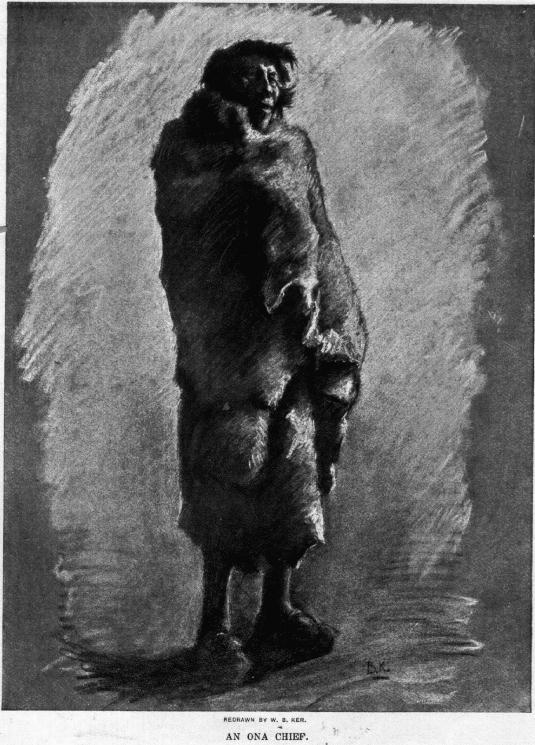
AN ONA CHIEF
[Description: Grayscale image of a man wrapped in fur]
REDRAWN BY W. B. KER
The honor of this enterprise is due to Mr. Steubenrach, the British consular agent. Steubenrach brought from the Falkland Islands a number of sheep, and fenced and stocked a small experimental farm. Anticipating trouble with the powerful Onas, who have always been the dread of white settlers in this region, Steubenrach secured, as one of his shepherds, a missionary to preach the gospel and morality and some other things to the Indians. This mission service was a diplomatic stroke, which was thought to be
At night, when all was quiet and the shepherds were asleep, confident of the effect of their pious training upon the Indians, the hunters came among the herds, cut the wire fences, and drove off such numbers as suited their appetites. These night raids continued month after month, but the Indians came in fearlessly in increasing numbers to listen to the gospel. At length, driven to distraction, the white men sent to Punta Arenas for Winchester rifles. Preaching was then abandoned, and the murderous sound of firearms has taken its place ever since. The
In defense of the pioneers it should be said that the Indians from the first have waged a constant and relentless warfare. A mutual understanding has at no time seemed possible, and if the pioneers would follow their business a vigorous defense was necessary. In spite of the destructive onslaughts of the Indians, however, the farms have flourished so well that to-day the number of sheep raised individually and collectively by the Fuegian rancheros is perfectly astonishing. There is one farm not yet quite stocked which will support six hundred thousand sheep. There are others of one hundred thousand, and a farm which does not herd twenty-five thousand is considered small. The profit over and above all expenses averages about fifty cents annually for each animal. This would give, for a farm of moderate size, a clear gain of fifty thousand dollars yearly, which is certainly a princely income for a farmer. The proprietors of these ranches are mostly men of large means, who live in luxury and comfort in the cities of South America and Europe.
The Ona population at present is about sixteen hundred, divided into sixteen tribes of about one hundred each. From this number there is a constant diminution. Many of the children have been taken from their wild homes bordering on the sheep-farms and placed in European families about Punta Arenas. These children thrive well at first, and are capable of considerable education, but few reach adult age. The minor children's diseases, such as measles and whooping-cough, are extremely fatal to them, and those who escape other diseases are almost certain to succumb to tuberculosis.
For a number of years the Indians, watching the encroachment of white men upon their territory, have made it as uncomfortable as possible for the intruders. To bag a settler was quite as much sport as to secure game, and the white men, in return, have shot Indians with as much elation as if they were hitting panthers. Killing has been in vogue on both sides, but the battle is uneven. The Indian must vanish before the lead of Christians. Such is the mission of modern civilization.
Migration from one part of the island to another, and from one clan to another, has been common, but the Ona has seldom left his chosen land. A few have been found in Patagonia, and occasionally one has been seen among the Yahgans and the Aliculufs; but these have only been stragglers who, by
Physically the Onas are giants. They are not, however, seven or eight feet in height, as the early explorers reported their neighbors and nearest relatives, the Patagonians, to be. Their average height is close to six feet, a few attain six feet and six inches, and a few are under six feet. The women are not so tall, but they are more corpulent. There is perhaps no race in the world with a more perfect physical development than the Ona men. This unique development is partly due to the topography of their country and to the distribution of game, which makes long marches constantly necessary. The Ona men are certainly the greatest cross-country runners on the American continent.
The mental equipment of the Ona is by no means equal to his splendid physical development. He understands very well the few arts of the chase which he finds necessary to maintain a food-supply. His game in the past has been easily gotten; his needs have been few, which fact accounts for the lack of inventive skill portrayed in the instruments of the chase. The home life, the house, the clothing—everything portrays this lack of progressive skill. Instead of the children being well dressed and well cared for, as is the rule among savage races, they are mostly naked, poorly fed, badly trained, and altogether neglected, not because of a lack of paternal love, but because of the mental lethargy of the people. It is the same as to shelter and garments. They have abundant material to make good tents and warm, storm-proof houses; but they simply bunch up a few branches, and throw to the windward a few skins, and then shiver, complaining of their miserable existence.
It has never fallen to my lot to listen to a language so odd, so strikingly peculiar, as that of the Onas. Some of my companions on the Belgica said that from a distance the talk of a group of Onas was like that of a group of Englishmen. To this I have protested, for that statement is certainly a libel on English. This might be said with considerable truth of the Yahgan tongue, which is smooth and easy; but of the grunting, choking, spasmodic talk of the Onas it is untrue. Many of the words are not difficult to pronounce, nor is the construction of sentences hard; but in every fifth or sixth word there is a sound impossible to reproduce by any one who has not had years of practice. These sounds offer sudden breaks in the flow of words, and the speaker, by efforts which suggest the getting of sounds from the stomach, struggles for something far down in his throat. He hacks and coughs and grunts, distorting his face momentarily in the most inhuman manner, and then passes on to the next stumbling-block, or whatever it is which makes the poor mortal suffer such tortures of speech. I always felt like offering him an emetic when I heard him talk.
Like all the American aborigines, the Onas feed principally upon meat, and this meat was in former years obtained from the guanaco. The guanaco roamed about in large herds upon the pampas and grassy lowlands, regions now in use as sheep-farms. The guanaco, like the Indian, is forced to the barren interior mountains, where life is a hard struggle against storms and barrenness and perennial snows. Owing to the present greater difficulty of hunting these animals and their reduced numbers, the Ona has taken most naturally to the sheep which have been brought to occupy these lands. That the sheep are owned by other men is a fact not easily recognized by Indians to whom the world of Fuegian wilderness has always been free. The many thousands of guanaco blanco, as the Onas call sheep, grazing peacefully upon the Indian hunting-grounds, make a picture full of irresistible temptation, as the aborigines, hungry and half naked, look from icy mountain forests down over the plains. Shall we call them thieves if, while their wives and children and loved ones are starving, they boldly descend and, in the face of Winchester rifles, take what to them seems a product of their own country?
Unfortunately, the Indians have had so many causes for revenge against the white invaders that they no longer capture sheep, as they did primarily, to satisfy the pangs of hunger, but to obtain vengeance. The wholesale manner in which they do this, however, would make a beggar of an ordinary farmer in a single night. In the neighborhood
The Indians spoke in broken Spanish, and said that they had been sent by the great chief Colchichoali to ask if the manager of this farm would make an arrangement for amicable and peaceful relations in the future. Colchichoali and his people had for a long time been on friendly terms with Mr. Bridges, a farmer on the southern shore. While here many had died and many others were sickly. It was the wrong season for them in the south. The winter was too cold there, the spirits were against them, and
Mr. Menendez replied in the affirmative, and then went on to qualify his offer. He said that at first he was not inclined to treat their demand seriously; that he suffered so much at their hands by unlimited thefts of so many thousands of sheep, and by their heartless destruction of his fences, etc., that he was not in an easy mood to harbor them near his farms; but if they promised to be good, if they agreed to steal no more sheep, he would give them the southern bank of a river about ten miles southward, where they might pitch their tents, hunt and fish, and live undisturbed. He further agreed that he would give them as much meat as they required.
The Indians returned to their chief to report the success of their mission. Owing to their lengthy stay, however, the chief thought that they had been killed, and in retaliation ordered the raiding of five hundred sheep, which, of course, made the consummation of an amicable agreement impossible. In defense of the Indians, however, it should be said that one year previous a similar arrangement had been entered into in good faith. The Indians came trustingly to a camp, where the entire company, men, women, and children, were seized by soldiers and exiled from the island.
The Onas have been masters of Tierra del Fuego, not because of the perfection of their implements of war, but because of their splendid physical force. The only destructive weapon which they have brought to effective use is the bow and arrow. The bow used by them is made of the wood of the Antarctic beech, which is scraped and worked into the desired shape by the sharp edge of one of the numerous shells which everywhere are found on the beach. The string is made of the sinews of the guanaco, neatly braided. The arrow-shaft is a reed-like branch of a tree called the Winter's bark; it is winged with feathers of native birds, and is tipped with a unique glass point.
In former years, before vessels entered the Strait of Magellan, and before the passage around Cape Horn was discovered, the Onas tipped their arrows with flint; but since white men have invaded these waters their misfortunes have been the fortunes of the Indians. From the many wrecks thrown upon the rocky shores during the last three hundred years, the aborigines have obtained glass, with which they now point their arrows, and also iron, of which they make knives. Within the last twenty-five years they have occasionally bagged an unwary gold-digger, and his kit has been added to their own imperfect implements of chase; but they have never been able to obtain ammunition, and so the rifles in their camp are of no use. The traders and farmers on the borderlands, with whom these Indians have to come in contact, have always been alive to their own interests. They have prudently refused to sell firearms or ammunition. If the Onas were able to obtain guns and supplies they would clear their island of pale-faced settlers in less than a month.
With the bow and arrow as their sole implement of chase, the Onas roam about always in the footprints of the guanaco from the barren interior mountains to the forest-covered lowlands, and during the winter from the forests over the pampas to the seashore. If they fail in securing their favored game, the guanaco, they capture a kind of ground-rat, or gather the snails and mussels of the beach; but the one grand aim of life is to hunt the guanaco.
Day after day in the chase the whole family march over windswept plains, through icy streams, into regions seemingly ever deserted by animal life. The women and children travel in one group, generally in gullies, winding around low hills, where they are out of sight of the game. The men scatter about as sentinels, mounting little elevations now and then, to search, with their eagle eyes, the undulating plains for a herd of guanaco. When on this weary chase they are always hungry, and generally but half clothed. The sick and the helpless aged are left by the wayside to starve or to support life as best they can, while the more vigorous go on and on famine-stricken until they come upon their game.
When in sight of guanaco the men seek to surround the entire herd by creeping on hands and feet and covering their bodies with the robe to imitate the animals. As they close in on them they rise, drop their robes, and naked spring upon the guanaco,
The matter of clothing, with the Onas, is a very simple affair. Although the climate of their region is cold, stormy, and even humid, they are very imperfectly dressed. The children run about in the snow either naked or nearly so. The men have a large mantle made of several guanaco-skins sewed together. This reaches from the shoulders to the feet, but it is not attached by either buttons or strings; it is simply held about the shoulders by the hands. On the chase the mantle is allowed to drop, while the hunter rushes on, naked, to capture his game. The women, when well dressed, wear a piece of fur about the waist, and another loosely thrown about the shoulders; but they are not often well dressed, and must generally be contented with a kind of mantle carelessly suspended from the shoulders, which is allowed to fall upon the slightest exertion.
Nothing could be more homeless than an Ona house. It is proof to none of the discomforts of Fuegian climate. Rain, snow, and wind enter it freely. The house is a simple accumulation of tree branches thrown together in the easiest possible manner. Sometimes it has a conical shape, but more often it is only a crescent or breastwork, behind which the entire family sit or sleep. To the windward are thrown a number of skins to keep out the wind, but from overhead the cold rains drizzle over poorly clad bodies, while the ground is always uncovered and cold. In the center of this circle of shivering humanity, or just outside of it, is a campfire, which, however, serves better for cooking purposes than for heating.
The arrangement of the house is such that the heat all escapes. At night the fires are allowed to go out, and the adults, lying in a circle, place the children in the center, with blankets of guanaco-skins spread over all. To keep the blankets from being blown off, and to add additional warmth, they next call their dogs to take their positions on the top of the entire mass of Indians. In former years it was a poverty-stricken family that did not have enough dogs to cover it out of sight; but the shepherds have now killed the dogs, and the Indians must rest cold and comfortless without their canine bedfellows.
There seems to be considerable love expended among the members of an Ona family. It is kindled with the first rays of childhood, and it is still burning at ripe old age. It is, however, a love which is never appreciated by a white man, nor is it ever tendered to him except for brief spasmodic periods. Nothing illustrates this point better than the experience of the pale-faced new-comers. Everybody who goes as a pioneer to the Cape Horn regions is a bachelor. All buy, borrow, or steal wives when they decide to settle down upon a gold-mine or a sheep-farm. The Indian women, it must be confessed, are not unwilling to be bought or stolen, but they are not to the white man what they are to the copper-faced rival. In the Indian household a wife may be but one of several; she can claim only a small share of her husband's affection; she must work hard, is badly dressed, and is always half starved: but she prefers this life as a steady thing to the entire heart of a paleface, with the luxuries which he brings to her.
Marriage, like almost everything Ona, is not fixed by established rules. It is arranged and rearranged from time to time to suit the convenience of the contracting parties. Women generally have very little to say about it. The bargain is made almost solely by the men, and physical force is the principal bond of union. For ages the strongest bucks have been accustomed to steal women from neighboring tribes, and from neighboring clans of their own tribe. The Onas, being by far the most powerful Indians, have thus been able to capture and retain a liberal supply of wives. A missionary who has been in constant contact with these Indians for thirty years has given it as his opinion that a plurality of wives is entirely satisfactory to their peculiar emotions and habits of life.
The relation of the women who possess but one husband in common in the family wigwam to one another is of novel interest. As a rule, they are no more jealous of one another than are the children in a civilized home circle. The principal reason for this is that the several wives are often sisters. A young man takes by force, by mutual agreement, or by barter, the oldest daughter of a family. If he proves himself a good hunter and a kind husband, the wife persuades her sister to join her wigwam and share her husband's affections. Frequently, when a girl is left an orphan, she is taken
The unwritten laws which govern the actions of the tribe as a whole are very vaguely understood. There never has been any very great need for the Onas to assemble and unite against an enemy. Any one of the numerous clans under one chief has been more than equal to overcome the feeble onslaughts of other Indians and white men. Hence the lack of tribal organization. In the family, however, the organization is firmly fixed by habits which never change. The loose arrangement of marriage and divorce does not seem to disturb seriously the equilibrium of the home circle. The camp is pitched from day to day at spots convenient for the chase. This makes elaborate houses or complex fixtures impossible. It never requires more than half an hour to build an Ona house.
The work of the man is strictly limited to the chase. He carries his bow and quiver of arrows, and his eye is ever on the horizon for game; but he seldom stoops to anything like manual labor that is not connected with the actual necessities of the chase. He kills the game, but the wife must carry it into camp. In moving, the women take up all of their earthly possessions, pack them into a huge roll, and with this firmly strapped across their backs they follow the unencumbered lead of their brave but ungallant husbands. Thus the women carry, day after day, not only the household furniture, but the children and the portable portions of the house. The women certainly have all the uninteresting detail and the drudgery of life heaped upon them, but they seem to enjoy it. In defense of the men it should be said that they are worthy husbands. They will fight fiercely to protect their homes, and they will guard the honor of their women with their own blood. It is a crying sin of the advance of Christian civilization that this red man of the far south should be compelled to lay down his life at the feet of the heartless pale-faced invaders to shield the honor of his home.
I doubt if missionary efforts will improve the hard lot of this noble band of human strugglers. The efforts thus far made have certainly had the contrary effect, and altogether they do not need a new system of morals as badly as we do ourselves. I do not mean to infer that missionary work, in general, is hurtful to aborigines. There is a legitimate field for such efforts, but it is not among Onas, unless the work is conducted in a new manner by a thoroughly practical man. They need to be placed in a position where they may follow their wild habits without the infectious degeneration of higher life. Individually and collectively they have fewer sins than New-Yorkers. It is true that there are among them no faultless characters, but there are also no great criminals. There are some good and some bad, but the worst and the best are found side by side.
The bitter and the sweet of human life flow in the same stream. They have the same origin and the same termination. The lesson of ages to untutored man has impressed upon him a prescription of moral direction, which is quite as good as, and far more appropriate for him than, the white man's code of ethics.
| The Giant Indians of Tierra Del Fuego | ||
